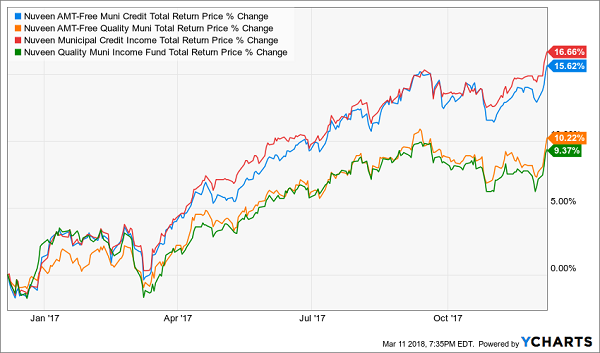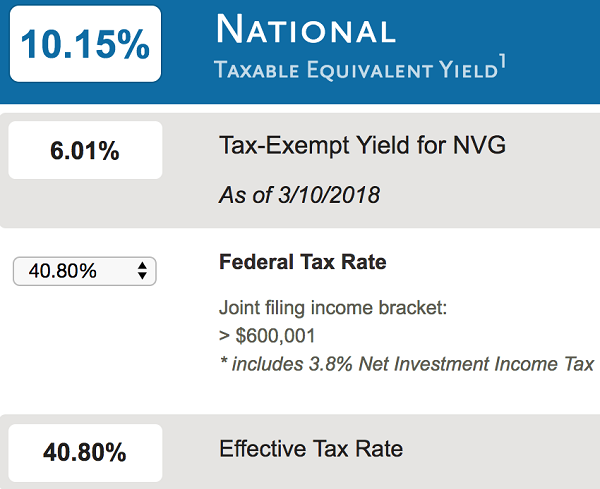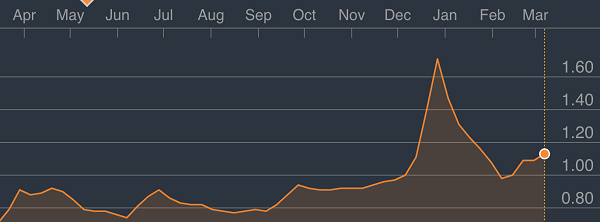Municipal bonds are off to a slow start in 2018 – which is usually a bullish sign for these tax-free payers.
We last “pounded the table” on munis in December 2016. They were coming off their worst month since the Great Recession, and we discussed their tendency to rally when they are hated:
“It’s impossible to call a top in yields (or bottom in munis) without the benefit of hindsight. But we contrarians make our money buying when nobody else wants to – and the last time munis were this hated, they returned 30-38% over the next 12 months.”
Turns out that was the bottom in munis. And on cue, they rallied for 12 months. The four funds we highlighted then delivered total returns (including their tax-free dividends) since between 9.4% and 16.7%:
Reminder: Buy Munis When They’re Hated

These bonds are back in the doghouse today, thanks to several “headwinds” (as the pundits say). Which risks are real, and which are overrated? Let’s discuss. (And then I’ll list my 10 favorite muni funds.)
Default Worries: Overrated
“Ticking time bomb” is a scary phrase tossed around with munis. The story goes that state and local government have pension obligations they won’t be able to pay someday. But income-hungry investors are picking up tax-free nickels on the train tracks in the meantime.
Historically, munis have actually been the safest bonds you could have purchased this side of U.S. Treasuries. While we read about the disasters in financial headlines, the reality is that very few of these loans tend to default. Muni bonds have averaged default rates below 0.2% for decades.
But 0.2% isn’t quite zero, so I wouldn’t buy a basket of munis cobbled together by a dumb computer algorithm. Pensions are a potential concern that needs to be evaluated on a case-by-case basis.
We need a smart muni manager who can curate a portfolio that’s safe from credit risk with yields worth our while (which I define as 5%+ and Federal tax exempt). This is doable – and we can even get our management fee comped if we buy right. More on this later.
Tax Plan Worries: Overrated
Munis sold off on the heels of the 2016 presidential election because investors mistakenly worried that lower individual tax rates would hurt demand for munis.
While rates have come down, they’re still quite high for high earners. For example, a 6% tax-free yield from Nuveen’s AMT-Free Municipal Credit Income Fund (NVG) is the equivalent of a 10.2% income stream for someone in the top bracket!
When a 6% Equals a 10.2% Payout

Tax-free income is still attractive, and demand for munis should remain strong. But will they be able to generate the income levels we’ve seen in the past?
Rising Rates & Leverage Costs: Fairly Rated
All of the muni funds you and I discuss use leverage. (If they didn’t, they wouldn’t be able to distribute 5%+ yearly yields.)
For example, NVG’s average coupon today earns it 3.9% in tax-free annual income. The fund then borrows money for 1.1% and buys more bonds to boost its portfolio’s yield to 5.4%.
You and I, meanwhile, can buy NVG for just 91 cents on the dollar today (thanks to its price’s current 9% discount to its NAV). Which boosts our yield to 6% (which is before we consider tax advantages).
It’s good living for everyone involved when money is this cheap. Muni funds borrow at rates determined by the SIFMA Swap index, which is published by Bloomberg. For the years leading up to the Fed’s current rate hike cycle, SIFMA was less than 0.1%. These funds were basically borrowing for free!
But a “SIFMA spike” to 1.7% in December roiled the muni market, providing us with the bargains we see today:

Source: (SIFMA.org, Bloomberg)
The folks at Nuveen correctly called the recent top and subsequent drop from 1.7% to 1.1% in December. They believe SIFMA will stay around these levels. Of course they also have several tax-free horses in this race (as we’ll see in a minute). Regardless, rising SIFMA is the potential problem we should keep an eye on (it’s published every week by Bloomberg).
Shopping List: Top 10 Blue Chip Muni Funds
Muni funds in general seem to be fairly priced here. Discounts are on the generous side, up to 12.6% amongst my favorites. This margin of safety is appropriate given the potential for more expensive borrowing costs.
Now if you’re in a high tax bracket, you may be fine with the “SIFMA overhand.” Many of you have requested more of my favorite muni funds – so here’s my top 10. Each fund:
- Has a market cap above $600 million,
- Pays a 5%+ Federal tax-free yield,
- Pays its distributions monthly,
- Trades at a discount to its NAV (net asset value, the market value of its muni bonds), and
- Has generated 6%+ returns on its NAV since inception.
(When it comes to muni funds, past performance is usually the best indicator of future results.)
Top 10 Blue Chip Muni Funds

Notice a pattern? It’s no coincidence that Nuveen, Invesco and BlackRock dominate the muni leaderboard. These firms have an “unfair advantage” over their competitors and especially over any individual money managers or investors who want to buy munis directly.
Simply put, they get the first phone call. These guys are buying bonds (and securing bargains) that you and I (and even bigger players) never get access to.
Fortunately, we can bridge this gap of unfairness simply by purchasing these funds. And since they trade at discounts to the value of their holdings, we can actually get our management fee “comped” with a free money kicker to boot.
And while I like these muni names today, I actually LOVE another group of monthly dividend payers even more today. These cash cows are setup to continue dishing secure 8%+ yearly payouts with double-digit price potential to boot.
Your Best Move Now: 8% Dividends AND Monthly Payouts
My “8% Monthly Payer Portfolio” focuses on the best monthly dividend buys at any given moment. As you can see, the yield alone makes this strategy quite compelling if you’re interested in retiring and making a living on your dividends alone.
With just $500,000 invested, my monthly payer portfolio will hand you a rock-solid $40,000-a-year income stream. That’s an 8% dividend yield … and it’s easily enough for most folks to retire on. (If you have $1 million to invest, you’re making $80,000 annually in dividends alone.)
The best part is you won’t have to go back to “lumpy” quarterly payouts to do it! Of the 19 income studs in this unique portfolio, 12 pay dividends monthly, so you can look forward to the steady drip of $3,333 in income, month in and month out—give or take a couple hundred bucks!
Recently I was chatting with a reader of mine who manages money for a select group of clients. He’s using my 8% Monthly Payer Portfolio to make a client’s modest savings – a nice grandmother with $387,000 – last longer than she ever dreamed:
“She brought me $387,000,” he said. “And wants to take out $3,000 per month for ten years.”
“Well she’s already withdrawn money for eight months (at $3,000 per month) and her balance has actually grown to $397,000. If the portfolio continues yielding 7% per year plus 2% per year in capital gains, and she withdraws $3,000 per month, it will pay my fees and still last her 27 years!”
Now many retirement experts pitch real estate as the best way to bank monthly income. But this grandma isn’t hustling to collect rent checks, or fix broken light bulbs. She’s simply collecting her “dividend pension” every month, which is 100% funded by her stocks and funds.
Actually her monthly salary is more than 100% financed – which is why her portfolio has grown by $10,000 as she’s withdrawn $3,000 per month.
I’m ready to give you everything you need to know about this life-changing portfolio now. Let’s talk about Grandma’s secret –and I’ll share the specifics on her 8% monthly dividend superstars (which even have 10% price upside to boot!)

Recent Comments